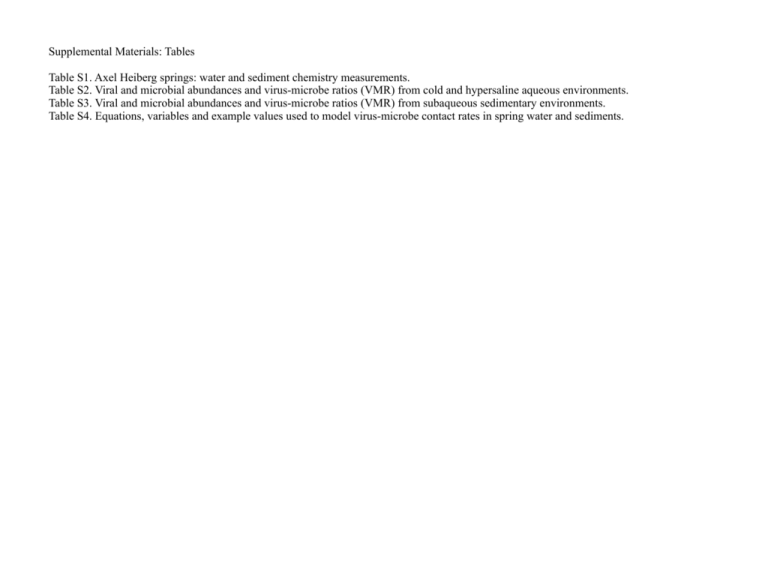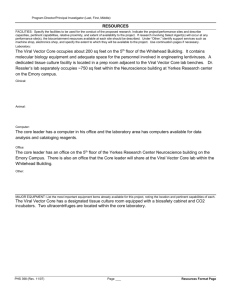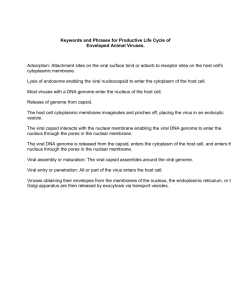Tables Table S1. Axel Heiberg springs: water and sediment
advertisement

Supplemental Materials: Tables Table S1. Axel Heiberg springs: water and sediment chemistry measurements. Table S2. Viral and microbial abundances and virus-microbe ratios (VMR) from cold and hypersaline aqueous environments. Table S3. Viral and microbial abundances and virus-microbe ratios (VMR) from subaqueous sedimentary environments. Table S4. Equations, variables and example values used to model virus-microbe contact rates in spring water and sediments. Table S1. Axel Heiberg Island springs: water and sediment chemistry measurements. Table S1. References. 1 Pollard, W., Omelon, C., Andersen, D., and McKay, C. (1999) Perennial spring occurrence in the Expedition Fiord area of western Axel Heiberg Island, Canadian High Arctic. Can J Earth Sci 36: 105–120. 2 Omelon, C.R., Pollard, W.H., and Andersen, D.T. (2006) A geochemical evaluation of perennial spring activity and associated mineral precipitates at Expedition Fjord, Axel Heiberg Island, Canadian High Arctic. Appl Geochem 21:1–15. 3 Perreault, N.N., Andersen, D.T., Pollard, W.H., Greer, C.W., and Whyte, L.G. (2007) Characterization of the prokaryotic diversity in cold saline perennial springs of the Canadian high arctic. Appl Environ Microbiol 73: 1532–1543. 4 Niederberger, T.D., Perreault, N.N., Tille, S., Lollar, B.S., Lacrampe-Couloume, G., Andersen, D., et al. (2010) Microbial characterization of a subzero, hypersaline methane seep in the Canadian High Arctic. ISME J 4: 1326–1339. 5 Battler, M.M., Osinski, G.R., and Banerjee, N.R. (2013) Mineralogy of saline perennial cold springs on Axel Heiberg Island, Nunavut, Canada and implications for spring deposits on Mars. Icarus 224: 364–381. 6 Lay, C.Y., Mykytczuk, N.C.S., Niederberger, T.D., Martineau, C., Greer, C.W., and Whyte, L.G. (2012) Microbial diversity and activity in hypersaline high Arctic spring channels. Extremophiles 16: 177–191. 7 This study Table S2. Viral and microbial abundances and virus-microbe ratios (VMR) from cold and hypersaline aqueous environments. Where ranges of values were reported, minimum and maximum values are listed, separated by a comma. Values for sea ice brines are calculated based on bulk measurements of salinity, microbial and VLP counts and partitioning coefficients for salt. Table S2. References Baxter, B.K., Mangalea, M.R., Willcox, S., et al. (2011) Haloviruses of Great Salt Lake: a model for understanding viral diversity. In Halophiles and Hypersaline Environments. Ventosa, A., Oren, A., and Ma, Y. (eds). Berlin Heidelberg: Springer-Verlag, pp. 173–190. Bettarel, Y., Bouvier, T., Bouvier, C., Carré, C., Desnues, A., Domaizon, I., et al. (2011) Ecological traits of planktonic viruses and prokaryotes along a full-salinity gradient. FEMS Microbiol Ecol 76: 360–372. Boujelben, I., Yarza, P., Almansa, C., Villamor, J., Maalej, S., Antón, J., and Santos, F. (2012) Virioplankton community structure in Tunisian solar salterns. Appl Environ Microbiol 78: 7429–7437. Brum, J.R., Steward, G.F., Jiang, S.C., and Jellison, R. (2005) Spatial and temporal variability of prokaryotes, viruses, and viral infections of prokaryotes in an alkaline, hypersaline lake. Aquat Microb Ecol 41: 247–260. Colangelo-Lillis, J., Eicken, H., Carpenter, S.D., and Deming J.W. (in review) Evidence for marine origin and microbial habitability of sub-zero hypersaline aqueous inclusions within permafrost near Barrow, Alaska. Collins, R.E., and Deming, J.W. (2011) Abundant dissolved genetic material in Arctic sea ice Part II: viral dynamics during autumn freeze-up. Polar Biol 34: 1831–1841. Guixa-Boixareu, N., Calderón-Paz, J.I., Heldal, M., Bratbak, G., and Pedrós-Alió, C. (1996) Viral lysis and bacterivory as prokaryotic loss factors along a salinity gradient. Aquat Microb Ecol 11: 215–227. Kepner, R.L., Wharton, R.A., and Suttle, C.A. (1998) Viruses in Antarctic lakes. Limnol Oceanogr 43: 1754–1761. Laybourn-Parry, J., Hofer, J.S., and Sommaruga, R. (2001) Viruses in the plankton of freshwater and saline Antarctic lakes. Freshw Biol 46: 1279–1287. Oren, A., Bratbak, G., and Heldal, M. (1997) Occurrence of virus-like particles in the Dead Sea. Extremophiles 1: 143–149. Table S3. Viral and microbial abundances and virus-microbe ratios (VMR) from subaqueous sedimentary environments. Where ranges of values were reported, minimum and maximum values are listed, separated by a comma. Table S3. References Bird, D.F., Juniper, S.K., Ricciardi-Rigault, M., et al. (2001) Subsurface viruses and bacteria in holocene/late pleistocene sediments of Saanich inlet, BC: ODP holes 1033B and 1034B, Leg 169S. Mar Geol 174: 227–239. Danovaro, R., Dell’Anno, A., Corinaldesi, C., Magagnini, M., Noble, R., Tamburini, C., and Weinbauer, M. (2008) Major viral impact on the functioning of benthic deep-sea ecosystems. Nature 454: 1084–1087. Engelhardt, T., Kallmeyer, J., Cypionka, H., and Engelen, B. (2014) High virus-to-cell ratios indicate ongoing production of viruses in deep subsurface sediments. ISME J 8: 1503– 1509. Hewson, I., O’Neil, J.M., Fuhrman, J.A., and Dennison, W.C. (2001) Virus-like particle distribution and abundance in sediments and overlying waters along eutrophication gradients in two subtropical estuaries. Limnol Oceanogr 46: 1734–1746. Mei, M.L., and Danovaro, R. (2004) Virus production and life strategies in aquatic sediments. Limnol Oceanogr 49: 459–470. Middelboe, M., Glud, R.N., and Finster, K. (2003) Distribution of viruses and bacteria in relation to diagenetic activity in an estuarine sediment. Limnol Oceanogr 48: 1447–1456. Middelboe, M., Glud, R.N., and Filippini, M. (2011) Viral abundance and activity in the deep sub-seafloor biosphere. Aquat Microb Ecol 63: 1–8. Siem-Jørgensen, M., Glud, R.N., and Middelboe, M. (2008) Viral dynamics in a coastal sediment: Seasonal pattern, controlling factors and relations to the pelagic–benthic coupling. Mar Biol Res 4: 165–179. Table S4. Equations, variables and example values used to model virus-bacteria contact rates in spring water and sediments.




